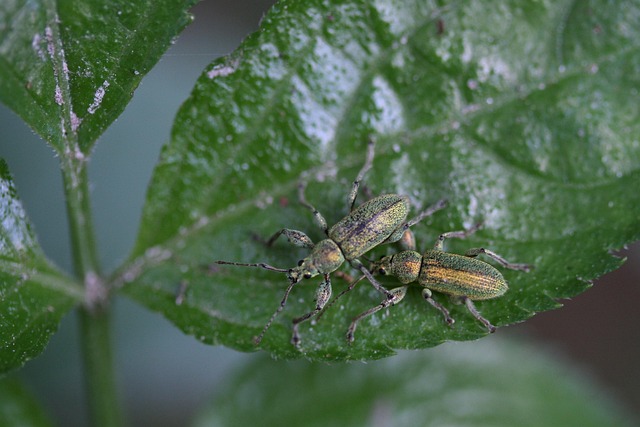Grain weevil infestations pose a significant threat to stored grains, seeds, and dried goods. Early identification of signs like adult beetles, larvae, or eggs is crucial for effective treatment. Professional cleaning services use advanced techniques like vacuums, washers, and chemicals to eliminate weevil eggs and larvae from hard-to-reach areas. Robust sanitation practices, including thorough vacuuming with HEPA filters and disinfectant sanitization, disrupt the weevil life cycle. Preventing future infestations requires a comprehensive strategy combining sanitation, storage practices, regular inspections, physical barriers, and monitoring systems. Implementing these measures protects stored grains, minimizes economic losses, and ensures long-term protection against grain weevil infestation treatment.
“Grain weevil infestations can wreak havoc on food storage facilities, causing significant damage to grains and posing health risks. Understanding these infestations is the first step towards effective control. This article delves into the intricacies of professional cleaning and sanitation as a powerful tool in combating grain weevils. We explore how specialized cleaning practices eliminate eggs and larvae, ensuring a pristine environment. Additionally, we offer preventative strategies to safeguard against future infestations, providing comprehensive guidance for efficient grain weevil infestation treatment.”
Understanding Grain Weevil Infestations: Identifying the Problem
Grain weevil infestations can be a significant problem for businesses and individuals dealing with stored grains, seeds, or dried goods. Understanding how these infestations occur is the first step in effective treatment. Grain weevils are small beetles that lay their eggs within crevices and cracks of infested materials. The larvae that emerge from these eggs feed on the host material, causing visible damage and potentially spreading to other nearby stores.
Identifying a grain weevil infestation early is crucial for successful treatment. Signs include the presence of adult beetles, discarded larvae or eggs, and distinctive frass (excrement) often left behind. Regular inspections of stored goods, especially in areas with high pest activity, can help detect infestations before they become severe. Once identified, prompt action is essential to prevent further damage and ensure effective grain weevil infestation treatment.
The Role of Professional Cleaning in Weevil Control
Professional cleaning and sanitation play a pivotal role in effective grain weevil infestation treatment. Specialized cleaning services employ advanced techniques to eliminate weevil eggs and larvae hidden within hard-to-reach crevices and corners of storage facilities. These professionals utilize powerful vacuum cleaners, high-pressure washers, and specialized chemicals to thoroughly clean and disinfect affected areas, disrupting the weevil life cycle and preventing further infestations.
Regular professional sanitation ensures that grain products remain free from weevil contamination. By implementing strict hygiene protocols, these experts remove residual eggs and larvae, which can be imperceptible to the naked eye. This proactive approach is crucial in industries where grain weevil infestation treatment is essential, such as food storage, logistics, and agriculture.
Effective Sanitation Practices to Eliminate Eggs and Larvae
Effective sanitation practices are paramount in managing and eradicating a grain weevil infestation. To eliminate eggs and larvae, thorough cleaning is essential, focusing on areas where weevils tend to hide and breed. This includes thoroughly vacuuming floors, walls, and corners, paying close attention to cracks and crevices. Vacuums with high-efficiency particulate air (HEPA) filters are ideal as they trap fine particles, including weevil eggs and larvae. After vacuuming, it’s crucial to dispose of the vacuum bag in a sealed plastic bag and immediately remove it from the premises to prevent reinfestation.
Sanitizing surfaces with appropriate disinfectants is another critical step. Use products specifically formulated to kill weevil eggs and larvae, following the manufacturer’s instructions for application and contact time. Pay special attention to areas where grains or infested materials have been stored. Regularly cleaning and sanitizing not only removes visible weevils but also disrupts their life cycle by destroying egg sacs and larvae, preventing future infestations in commercial and residential settings alike.
Preventive Measures for Future Weevil Infestations
Preventing future grain weevil infestations is a multi-faceted approach that combines sanitation, storage practices, and regular inspections. Once a grain weevil infestation is successfully treated, it’s crucial to take proactive steps to deter reinfestation. This includes thoroughly cleaning all affected areas, removing any potential food sources, and ensuring proper storage conditions. Regularly inspecting stored grains and implementing strict hygiene protocols can significantly reduce the risk of future infestations.
Additionally, integrating physical barriers like insect meshes and sealants in storage facilities creates a defensive line against weevils. Monitoring systems that detect early signs of infestation enable swift action, making it easier to eradicate weevils before they reproduce and spread. Employing these preventive measures not only helps maintain the integrity of stored grains but also minimizes economic losses associated with grain weevil infestation treatment.
Addressing a grain weevil infestation requires a multi-faceted approach, from understanding the problem to implementing effective sanitation practices. Professional cleaning plays a crucial role in removing weevil eggs and larvae, ensuring a thorough and efficient control measure. By combining these methods with preventive actions, you can successfully treat existing infestations and deter future ones, maintaining a clean and safe environment for your stored grains. For comprehensive grain weevil infestation treatment, it’s essential to adopt these strategies as part of an ongoing safety protocol.
